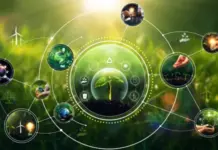By Patrice Lewis,
Last week I wrote about the potentially catastrophic implications of a global fertilizer shortage. Modern agriculture is scarily, frighteningly dependent on commercial fertilizers to feed the world. “Half the world’s population gets food as a result of fertilizers … and if that’s removed from the field for some crops, [the yield] will drop by 50%,” Svein Tore Holsether, head of agri company Yara International, told the BBC.
That’s a terrifying statistic, one that should strike fear even into the hearts of comfortable American urbanites. It’s a triple-whammy: less food on the international market, scarce fertilizer and skyrocketing gas prices (which translates to higher transportation costs). What can be done?
Since commercial agriculture is dependent on commercial fertilizer, non-commercial agriculture may become necessary to bridge the gap. In other words, it’s time to bring back Victory Gardens.
A Victory Garden – sometimes called a crisis garden – is simply a small garden squeezed into any available spot of dirt to supplement food sources during times of national emergencies (such as world wars). They were planted in yards, vacant lots, parks, sports fields, golf courses, roof tops, railway edges, and even bomb craters. Some were planted through community efforts, but many were simply individual endeavors.
Historically, planting Victory Gardens was encouraged to relieve pressure on an overburdened food system so more food could be shipped to soldiers. Governments urged civilians to do their patriotic duty and “sow the seeds of victory.” The cumulative harvest of millions of tiny gardens saved many nations from starvation. Read that again: The cumulative harvest of millions of tiny gardens saved many nations from starvation. During World War II, about one-third to one-half of America’s fruits and vegetables came from Victory Gardens. That is a staggering proportion.
And this, dear readers, may be the key. Right now it’s early spring. In temperate climates, it’s the perfect time to get started planting your Victory Garden.
Victory Gardens were not (necessarily) massive parcels capable of feeding entire neighborhoods. Most were small and concentrated plots tucked into odd corners and unused spaces. Most people focused on just a few staple vegetables, with surplus passed around and swapped. (“I’ll trade you a bushel of my carrots for a gallon of your strawberries.”) Neighbors traded with neighbors, family with family, friends with friends.
A Victory Garden is a collective effort. When an ant returns to the nest with a bit of food, it doesn’t expect that bit to feed the colony for a year. But the collective effort of all the ants will, indeed, feed the colony. That’s how Victory Gardens work. That’s why the cumulative efforts of these tiny plots have saved nations from starvation in the past.
What should you plant in a Victory Garden? Obviously this will depend on your amount of space, location, tastes, agricultural zone, amount of sunlight and a host of other factors; but keep in mind calories and nutrition. High-calorie choices include potatoes, sweet potatoes, Jerusalem artichokes, green and dry beans, corn, etc.
If seeds are in short supply online or in your local big box stores, there are some alternatives:
- Ask your gardening friends for any surplus seeds they can spare.
- Try local hardware stores, animal feed stores, smaller home and garden stores, and grocery stores. Even dollar stores often carry seeds.
- Check farm supply stores for bulk seeds such as corn, beans, peas, seed potatoes and onion sets. These can be divvied up among gardening friends and neighbors.
- If you have seed packets that are several years old, don’t hesitate to plant them even if they’re “expired.” Germination rates may be lower than with fresh seeds, but who cares?
- Try seed exchanges. These are nonprofit or volunteer groups of passionate gardeners who conserve and share seeds. Seed exchanges can be local, regional, or national.
- A surprising number of ordinary items from the grocery store can be grown. Think in terms of dried beans (any type), popcorn, raw peanuts (do NOT remove the paper skin or they won’t grow), raw sunflower seeds (in the shell), and spice seeds such as poppy seeds, coriander, fennel and mustard seeds.
- Harvest seeds from grocery store produce. Tomatoes, bell peppers, cucumbers, zucchini, melons, fresh corn (let the kernels dry on the cob first) – all have seeds which can be planted. Of course you won’t know if the produce is hybrid or not, but plant them anyway. What do you have to lose? The worst that can happen is the resulting plant may not be identical to its parent plant.
- Sprout new plants from leftover root ends of grocery-store produce. This method often requires nothing more than a jar of shallow water (into which the root end is placed) and a sunny windowsill. Change the water when it gets cloudy. People are growing leeks, green onions, cabbage, lettuce, celery, bok choy, mint, basil, rosemary, and fennel fronds. Commercial potatoes and sweet potatoes are often treated with a sprouting inhibitor, but many people have fine success in growing them anyway (make sure each planted piece has at least one eye). People have even sprouted avocado pits, raw coffee beans and pineapple tops.
Balconies, patios, backyards, window boxes, pots on the front steps or stoop – I don’t care where you are or how little space you have, USE IT. If you have any outdoor space to call your own, USE IT. There are endless tricks for packing many plants into tiny growing spaces (think “vertical”). Now is the time to learn. You have no excuse not to do something, anything.
What if you have no space to garden? With few exceptions, I don’t believe you. If you have a window, you have space. Pots of herbs, sprouting some green onions, a hanging basket of strawberries – every little bit helps. I’ve even seen people train climbing beans to wrap around the perimeter of a window frame as a “house plant.”
Now is not the time to look to the government to save you, especially the inept and bumbling government under the current administration. Food is a universal requirement, and the threat of an engineered global famine is not something to dismiss.
Nor is this the time for normalcy bias, claiming “it can’t happen here” or “it can’t happen to me.” Instead, this is the time to pump your fist in the air, take personal responsibility, and do something useful and productive toward food security. Plant a Victory Garden.
Source: https://www.wnd.com
Disclaimer: We at Prepare for Change (PFC) bring you information that is not offered by the mainstream news, and therefore may seem controversial. The opinions, views, statements, and/or information we present are not necessarily promoted, endorsed, espoused, or agreed to by Prepare for Change, its leadership Council, members, those who work with PFC, or those who read its content. However, they are hopefully provocative. Please use discernment! Use logical thinking, your own intuition and your own connection with Source, Spirit and Natural Laws to help you determine what is true and what is not. By sharing information and seeding dialogue, it is our goal to raise consciousness and awareness of higher truths to free us from enslavement of the matrix in this material realm.
 EN
EN FR
FR



























Here's positive news about a Russian initiative to support the Ukraine citizens with food supplies:
https://twitter.com/i/status/1507779947020144643
The Russian Army Provides Humanitarian Aid to Ukrainian Residents – Eva Bartlett Reports
Alejandro Kirk: "Is this issue really covered by the mainstream media in the West?"
Eva Bartlett: "Absolutely not. And it might seem strange, but I've been taking photos of the actual aid packages, what goes into the boxes or the bags, because I know, the predictable Western response will be 'Well, they're empty' or something like that. But they contain a variety of proteins, vegetables, chocolate, [and] water, obviously. [This is] what's not going to be reported on in Western media, or they will say, 'This is just a stage, that these are just actors, or this is just happening in one region.' We've seen a few regions already, and we've only been here for a couple of days."
Source: https://t.me/VigilantFox/3606
Thank you, for sharing this valuable article! A practical approach to prepare us for trying times.
I'm volunteering in an oyster-mushroom nursery, using leftover coffee ground from the university and its hospital. Local restaurants are buying the harvest, and in dry form by shops. Farmers collect all leftovers of organic material for their land.
The mushroom substrate is a ground cover and fertilizer, after the harvest.
A laboratory annex workshop with glass walls, a used kitchen-unit from IKEA, is my workspace on the terrain of an ecological garden centre.
A large team of entrepreneurs is creating awareness by offering education, workshops, and festive seasonal events, for now and for the future.
Some are mavericks, ex-business owners making a career change, managers who left the ratrace in material gain and competition, some with technical know how, and others with creative skills used with sharp intelligence.
Also students, stagieres, and volunteers like me, a life long one, all in an interesting mix of nationalities.
Returning to the mushroom world, all its growth is in sea containers with a climate control system, and a cooling space is for storage.
Many educational aspects are part of this pioneering initiative, and there are regular visits of workteams from organisations involved in the management of agriculture, education in recycling, re-use, zero waste, and climate change.
I'm happy to do my bit, working with those who think outside the box with me 😉
We Dutchies live below the sea level in many parts of the Netherlands, which is a riverdelta, at risk of flooding in the south, when snow melts in the Alps and fills the rivers Rhine, Waal and Meuse.
Last summer, Germany, and our Southern counties were severely flooded, after a long period of rain.
Never before, in summer! has this happened.
Hence our huge investment in water control, and wind-energy at sea, removing pavement from our gardens, growing veggies and flowers.
It's great to support the local economy, and a number of Dutch cities introduce a local currency, real money, also to help many small businesses in survival hardship during the last 2 years.
The damage won't be undone by the governments, as long as their members' moral standards are compromised.
Those of us who know how to navigate our boat on the ocean of our lives, will feed the fire that burns clean, so that new ideas with a change of thoughts and practice can grow roots and shoots in the ashes of a world view and reality that we are beginning to leave behind, gradually moving away from it.
At times, in nervous anticipation, for every step is as much a trying out of what works for us, as it is part of our new reality creation. That's why I use to say "We are the changers and the changed at the same time"
It's a reminder to not be too harsh on my/one-self, while active in being part of the change. As much a subject as an object in that process.
To me, it's the make of heroes and heroines 🧙♀️🧙♂️👨🔧👩🔧👩🚀👨🚀🤴👸🕵️♂️🕵️♀️
Where I live, I would like the following plants, all of which can be looked up at Plants For A Future.
(They need at least £1000 / US$1300/ €1200 every month; to help them financially, here's their website: https://pfaf.org – have fun looking up the following plants there!)
Vitis riparia (riverbank grape; has anyone thought about making a pergola-themed canopy bed?)
Amelanchier alnifolia (commonly known as Juneberries, serviceberries and saskatoons; I would like to try tea made by steeping its leaves)
Prunus virginiana (Western chokecherry)
Sambucus caerulea (Blue elder and blue elderberry)
Acer grandidentatum (I would like to try the sap of that kind of maple tree.)
Juniperus scopulorum (Rocky Mountain Juniper; I'm open to coffee substitutes)
Mahonia repens (Creeping grape)
Ribes aureum (Golden flower currant)
Ribes cereum (Wax currant)
Ribes inerme (White-stem gooseberry)
Ribes niveum (Snow currant)
Rosa woodsii (Western wild rose)